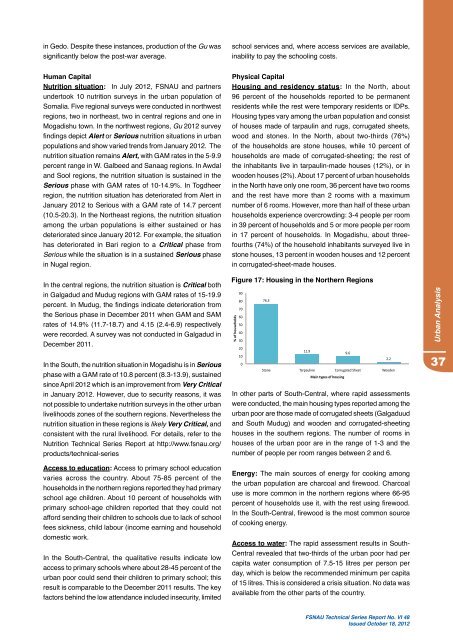Fsnau-Post-Gu-2012-Technical-Report
Fsnau-Post-Gu-2012-Technical-Report
Fsnau-Post-Gu-2012-Technical-Report
Create successful ePaper yourself
Turn your PDF publications into a flip-book with our unique Google optimized e-Paper software.
in Gedo. Despite these instances, production of the <strong>Gu</strong> was<br />
significantly below the post-war average.<br />
Human Capital<br />
Nutrition situation: In July <strong>2012</strong>, FSNAU and partners<br />
undertook 10 nutrition surveys in the urban population of<br />
Somalia. Five regional surveys were conducted in northwest<br />
regions, two in northeast, two in central regions and one in<br />
Mogadishu town. In the northwest regions, <strong>Gu</strong> <strong>2012</strong> survey<br />
findings depict Alert or Serious nutrition situations in urban<br />
populations and show varied trends from January <strong>2012</strong>. The<br />
nutrition situation remains Alert, with GAM rates in the 5-9.9<br />
percent range in W. Galbeed and Sanaag regions. In Awdal<br />
and Sool regions, the nutrition situation is sustained in the<br />
Serious phase with GAM rates of 10-14.9%. In Togdheer<br />
region, the nutrition situation has deteriorated from Alert in<br />
January <strong>2012</strong> to Serious with a GAM rate of 14.7 percent<br />
(10.5-20.3). In the Northeast regions, the nutrition situation<br />
among the urban populations is either sustained or has<br />
deteriorated since January <strong>2012</strong>. For example, the situation<br />
has deteriorated in Bari region to a Critical phase from<br />
Serious while the situation is in a sustained Serious phase<br />
in Nugal region.<br />
In the central regions, the nutrition situation is Critical both<br />
in Galgadud and Mudug regions with GAM rates of 15-19.9<br />
percent. In Mudug, the findings indicate deterioration from<br />
the Serious phase in December 2011 when GAM and SAM<br />
rates of 14.9% (11.7-18.7) and 4.15 (2.4-6.9) respectively<br />
were recorded. A survey was not conducted in Galgadud in<br />
December 2011.<br />
In the South, the nutrition situation in Mogadishu is in Serious<br />
phase with a GAM rate of 10.8 percent (8.3-13.9), sustained<br />
since April <strong>2012</strong> which is an improvement from Very Critical<br />
in January <strong>2012</strong>. However, due to security reasons, it was<br />
not possible to undertake nutrition surveys in the other urban<br />
livelihoods zones of the southern regions. Nevertheless the<br />
nutrition situation in these regions is likely Very Critical, and<br />
consistent with the rural livelihood. For details, refer to the<br />
Nutrition <strong>Technical</strong> Series <strong>Report</strong> at http://www.fsnau.org/<br />
products/technical-series<br />
Access to education: Access to primary school education<br />
varies across the country. About 75-85 percent of the<br />
households in the northern regions reported they had primary<br />
school age children. About 10 percent of households with<br />
primary school-age children reported that they could not<br />
afford sending their children to schools due to lack of school<br />
fees sickness, child labour (income earning and household<br />
domestic work.<br />
In the South-Central, the qualitative results indicate low<br />
access to primary schools where about 28-45 percent of the<br />
urban poor could send their children to primary school; this<br />
result is comparable to the December 2011 results. The key<br />
factors behind the low attendance included insecurity, limited<br />
school services and, where access services are available,<br />
inability to pay the schooling costs.<br />
Physical Capital<br />
Housing and residency status: In the North, about<br />
96 percent of the households reported to be permanent<br />
residents while the rest were temporary residents or IDPs.<br />
Housing types vary among the urban population and consist<br />
of houses made of tarpaulin and rugs, corrugated sheets,<br />
wood and stones. In the North, about two-thirds (76%)<br />
of the households are stone houses, while 10 percent of<br />
households are made of corrugated-sheeting; the rest of<br />
the inhabitants live in tarpaulin-made houses (12%), or in<br />
wooden houses (2%). About 17 percent of urban households<br />
in the North have only one room, 36 percent have two rooms<br />
and the rest have more than 2 rooms with a maximum<br />
number of 6 rooms. However, more than half of these urban<br />
households experience overcrowding: 3-4 people per room<br />
in 39 percent of households and 5 or more people per room<br />
in 17 percent of households. In Mogadishu, about threefourths<br />
(74%) of the household inhabitants surveyed live in<br />
stone houses, 13 percent in wooden houses and 12 percent<br />
in corrugated-sheet-made houses.<br />
Housing in the Northern Regions<br />
Figure 17: Housing in the Northern Regions<br />
% of households<br />
90<br />
80<br />
70<br />
60<br />
50<br />
40<br />
30<br />
20<br />
10<br />
0<br />
76.3<br />
11.9<br />
Stone Tarpauline Corrugated Sheet Wooden<br />
Main types of housing<br />
In other parts of South-Central, where rapid assessments<br />
were conducted, the main housing types reported among the<br />
urban poor are those made of corrugated sheets (Galgaduud<br />
and South Mudug) and wooden and corrugated-sheeting<br />
houses in the southern regions. The number of rooms in<br />
houses of the urban poor are in the range of 1-3 and the<br />
number of people per room ranges between 2 and 6.<br />
Energy: The main sources of energy for cooking among<br />
the urban population are charcoal and firewood. Charcoal<br />
use is more common in the northern regions where 66-95<br />
percent of households use it, with the rest using firewood.<br />
In the South-Central, firewood is the most common source<br />
of cooking energy.<br />
Access to water: The rapid assessment results in South-<br />
Central revealed that two-thirds of the urban poor had per<br />
capita water consumption of 7.5-15 litres per person per<br />
day, which is below the recommended minimum per capita<br />
of 15 litres. This is considered a crisis situation. No data was<br />
available from the other parts of the country.<br />
9.6<br />
FSNAU <strong>Technical</strong> Series <strong>Report</strong> No. VI 48<br />
Issued October 18, <strong>2012</strong><br />
2.2<br />
Urban Analysis<br />
37


